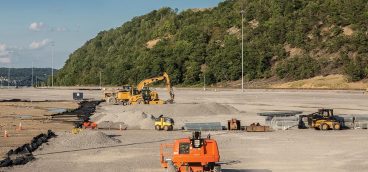Show Me the Money

It was hailed as a game changer. Almost immediately after the first Marcellus Shale natural gas well was spudded in a rocky hilltop in Washington County, unleashing for the first time a vast cache of domestically produced energy, the discovery was hailed as the harbinger of a revolution in energy production that would pump upwards of a trillion dollars into the economy.
Much of that, it was claimed, would flow into the pockets of poor farmers, down-on-their-luck merchants, businessmen and entrepreneurs, and, even more important, into the coffers of local and county governments and the state’s treasury.
It is virtually impossible, researchers and economists say, to determine how many dollars generated by the activity in the Marcellus in Pennsylvania have flowed out of state, to corporate headquarters in Oklahoma or Texas, or to out-of-state contractors. Those details are proprietary and guarded closely by the industry.
Still, in the years since the Marcellus boom began, billions of dollars have in fact flowed into the state. Some people have suddenly become rich beyond their wildest dreams. Others, however, have found that they are bearing the costs associated with this new technology—the traffic, the noise, the burden caused by the sudden industrialization of once-remote areas and all the stress which that places on an aging infrastructure—but so far, they have gotten little in return.
Even now, more than seven years after the Marcellus land rush began, state officials, academics and economists who have the trust of the industry say they have only a partial picture of the overall economic effects it has already had, and can do little more than guess what the long-term economic effects will be.
Some, like Timothy Considine, a professor of energy economics at the University of Wyoming, whose economic impact studies have been supported by the Marcellus Shale Coalition, argue that the Marcellus development has already had a profound effect on the state’s fortunes.
According to his most recent study, released last July, the industry generated $11.2 billion in value to the state’s economy and supported more than 139,000 jobs in 2010, a period in which the number of wells drilled in the state doubled, as did the number of jobs supported directly or indirectly by the industry—up from 68,168 jobs in 2009.
Those numbers are particularly impressive, Considine says, considering that they occurred at a period of time when most of the country was seeing a dramatic contraction in the labor force.
And it was clearly a significant jump from the first few years of the Marcellus development, between 2007 and 2008 for example, when counties with 10 or more Marcellus wells saw the number of income tax filers reporting taxable compensation increase by an anemic 0.4 percent—two-tenths of a percent less than those counties where there was no Marcellus activity at all. To most economists studying the issue, that’s a clear sign that as the Marcellus expands, so do its economic benefits.
There is no question that in many places across the state, Marcellus investment has already had a significant and measurable impact. Nowhere is that more clear than in the Pittsburgh region. Between 2009 and 2010, the greater Pittsburgh region saw its gross domestic product rise by 5.41 percent, nearly a point and a half above the benchmark average for 15 comparable regions. Part of that is attributable to the region’s developing role as the de facto capital of the Marcellus drilling industry. And between December 2010, and the end of 2011, the number of jobs in mining, natural resources and construction in the Pittsburgh region rose by 6.83 percent—a significant increase at a time when, in most areas of the country, construction spending was depressed.
State tax records, which bore down to the county level, indicate that there is no question that from the very moment the genie in the Marcellus bottle was released there was profound economic impact. One question is, has that rising tide really lifted all boats, or have the benefits—and the costs—been distributed in a more haphazard fashion?
As Sharon Ward, executive director of the Pennsylvania Budget and Policy Center, a non-partisan think thank that analyzes the state’s fiscal policies, put it, “Individuals have benefited from this, and more power to them. But I’m not sure that we’ve seen yet a broader economic benefit across communities. And I’m not sure if we will.”
The record is mixed, according to state tax records and interviews with economists, state officials and industry representatives.
Certainly, leasing, drilling and production from the Marcellus has swelled the state’s coffers. Overall, between 2006, when exploration of the Marcellus began in earnest, and 2010, the state’s take from corporate income tax swelled by some $1.57 billion, with the lion’s share of that revenue coming in 2008, 2009, and 2010, during the worst economic downturn to rock the country since the Great Depression, and during an anemic and fragile recovery that in many parts of the country doesn’t seem like a recovery at all.
In one suddenly gas-rich county alone—Bradford, in the north-central part of the state—drilling and its related industries have spent more than $1.5 billion in their operations since leasing and drilling began; an amount that nearly equals the county’s own budget for that same time period, according to a study conducted by Penn State’s rural economics professor Tim Kelsey. And yet, as Kelsey notes, the amount of money that actually remained in that county was not commensurate. “Bradford’s budget didn’t double,” Kelsey said.
And that, he says, may be an indication that, at least in those areas most affected by the drilling—those more remote regions of the state where local authorities have to contend with increased traffic, demand for public services, and burdens on the infrastructure and the economy—the gas from the Marcellus may not be the only thing that’s getting shipped out. So too is the economic bounty. In some cases, one section of a county might have benefited in the early days of the boom while another part did not. In other cases, counties adjacent to active drilling fields prospered while the counties that host the activity saw fewer benefits, researchers say.
An analysis of the personal income tax (PIT) payments collected by the state on oil and gas revenues illustrates the point. In 2006, at the dawn of the boom, the state collected $15.2 million in oil and gas-related PIT payments. The next year, as the drive to secure leases gained steam, that number increased to more than $28 million, and in 2008, the year in which lease prices exploded—rising from a few hundred dollars an acre to over $5,000 an acre in some highly prospective regions in the southwest and northeast corners of the state—and as the first royalty checks began to arrive in landowners’ mailboxes, PIT payments jumped to $66.6 million. Then in 2009, as leasing activity fell off dramatically, in part because of the collapsing economy and in part because of a precipitous fall in natural gas prices that reduced the size of royalty checks landowners received, that number declined slightly, dropping down to $45.5 million. In 2010, as more wells came on line, and more still comparatively smaller royalty checks turned up in people’s mailboxes, that number stabilized at $46.2 million. The figures for 2011 aren’t available yet, and it’s still too early to assess the impact of this year’s even more dramatic decline in natural gas prices, which dropped to $2.36 per thousand cubic feet, the lowest price in more than two decades, because of record supplies and historically low demand as a result of the unseasonably warm winter of 2011–12.
The $46.2 million in personal income tax related to oil and gas is a respectable number as a measure of economic activity and three times higher than it was in 2006. And while it is only a fraction of the $1.5 billion in all categories of tax revenue the state collected from drilling-related activities in 2010, there is little evidence that the communities in which the drilling is taking place are experiencing a proportional boost in their economic fortunes.
The optimistic early assessments were that investments in leases and royalty checks would boost local economies. Those assessments were accurate up to a point. In Washington County, where the drilling boom began, the taxable income of residents rose from $3.71 billion in 2006 to $4.03 billion in 2009. More than a quarter of that—$1.2 billion—came from rents and royalties, a category that, while it does not exclusively reflect money from mineral leases and gas royalties, does reflect the money the drilling industry funneled to the landowners during a major economic recession, analysts say.
But those royalties and lease payments, at least in the early days, did not necessarily trigger an economic boom in the areas where the activity was the hottest. Part of the problem is that in many of the state’s rural areas—the areas where drilling is most active—landowners are frequently part-timers. A person who owns a hunting camp or gentleman’s farm in Sullivan County may actually pay his income tax and spend his money in Lancaster County. And in some cases, mineral rights, specifically natural gas rights, may have been separated from properties in the past, and the owner of those rights may live in another part of the state or another state altogether. That issue has recently gained traction as a result of a lawsuit filed in Susquehanna County that has called into question the validity of a number of leases across the state. The industry contends that the pending suit will have a comparatively minor impact since in the majority of leases, the owners of the surface rights, the mineral rights and the gas rights are the same.
However, even in the majority of cases, where the landowners are residents of the counties their property is in, and where their claim to the gas is not in question, the overall economic impact has been muted.
The bottom line, say economists, is that the state lacked the economic infrastructure at the time the boom began to effectively harness the money that was flowing into areas that had been depressed for a generation.
“The dollars [had been] going to local landowners, “ Kelsey said. “They’ve got that income, and that’s very good for them, but there are not a lot of places for them to spend money.”
A case in point is Susquehanna County, which had 338 drilling permits issued in 2011, making it one of the most active Marcellus drilling fields. According to U.S. Census figures from 2000, the most recent available, more than half of the residents of the county—52 percent—worked elsewhere. That is an indication that the county effectively lacked the commercial infrastructure to capture that newfound wealth and build on it.
“They’re not there to spend the dollars locally,” Kelsey said. In many cases, the money that flowed from the drillers to the landowners either wasn’t spent at all, or was spent elsewhere. In the first days of the gas boom, there were a number of published reports citing examples of down-on-their-luck farmers who had suddenly come into money from leasing and drilling, with the implication that those landowners would begin making big-ticket purchases, buying new cars and trucks and tractors. And there was some of that, Kelsey says. “Based on the survey we did, a lot of it is spent on vehicles, other kinds of durable goods.”
But those sorts of purchases are often not made in the areas where the drilling is taking place. They are made in the more economically developed areas adjacent to the drilling fields. And even then, most of the money is not staying in the region or even in the state. “If somebody bought a $20,000 tractor or a $30,000 car, even if they bought them in Montrose (Susquehanna County) or Binghamton (N.Y.) it’s not staying in Montrose or Binghamton. The majority of those dollars are immediately going back to Detroit, to GM or Toyota or wherever. So of that durable good purchase, only a relatively small percentage of that purchase actually stays with the dealer, stays in the community.”
Nor did the first boom days of the Marcellus set in motion an immediate hiring boom. In fact, between 2007 and 2008, counties with no Marcellus wells actually saw a greater increase—albeit still a small one—in the number of income tax returns filed than did active Marcellus counties, an indication that the drillers were relying on workers they already had—in many cases imported from out of state. In the years since, hiring did increase within the industry itself and also in businesses that do business with the industry.
That is not to say that there was no positive impact from the sudden expansion of wealth due to leasing and drilling, or from the comparatively small increase in the drilling industry’s work force at the time.
According to the state’s tax figures, as taxable income from Marcellus royalties increased by 325 percent between 2007 and 2010 in counties with 10 or more Marcellus wells, sales tax revenues increased as well. Counties with 150 or more wells—places like Washington, Bradford and Susquehanna—saw their sales tax revenues increase 11.6 percent, while those counties with few wells saw a modest decline, and those with no wells saw a steep decline. And it bears repeating that any increases at all between 2007 and 2010 are remarkable, given that those years were in the trough of what economists have described as the deepest and most prolonged global economic downturn since the 1930s.
Those figures reflect not only the money received by landowners, but also the money being spent on everything from chewing gum to steel pipe by the drillers and their contractors.
But many of those expenditures seem to be benefiting the areas surrounding the drilling fields—and some, like Pittsburgh and Williamsport, appear to have benefited significantly—but that wealth has not necessarily accrued to the affected communities themselves.
“If a truck driver is working out of Williamsport, for a company that’s based in Williamsport or Oklahoma or whatever, they’re driving into Susquehanna County to pick up water and they’re driving out to deliver it somewhere else, going in and out. Other than driving on the roads in the county, unless they’re buying fuel, unless the guy or woman stops to buy a sandwich… are they touching the Susquehanna County economy at all?” Kelsey asked.
“One of the things that’s been striking to me is the news out of Washington and out of Lycoming counties. Those two places are doing very well, seeing a lot of employment growth, a lot of firms locating there; they’re growing very quickly. But they’re the ones that are growing as a result of the drilling activities around.”
The question, he says, is “Who has been bearing the cost and who is receiving the benefit?”
“These firms, all of them don’t need to locate in Susquehanna County. A lot of them are going to the Williamsport area—Williamsport is booming. But these places that are dealing with the traffic and all of the negatives are not getting as much of a boost. They see all those trucks, they see all that hubbub of activity, but the bottom-line question is… in what ways does that activity actually touch the local economy?”
“This has raised a lot of red flags for me about… the overall impact,” Kelsey said.
“Good or bad, it raises a lot of questions—like what are some of the economic development initiatives that can capture some of those dollars?”





